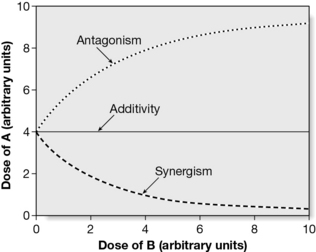Chapter 11 What makes phytomedicines unique?
Also, there is a continuum between products which are a (health) food and those which are a potent herbal medicine (called the food–medicine interface). In the area of food research, considerable efforts have been put into understanding the benefits of a ‘balanced diet’ and thus a diet which is composed of a complex combination of mixtures. However, in medicines research in general and specifically in research on herbal medicines systematic research has only been developed since the start of this century (Williamson 2001).
Generally, highly toxic drugs are used as single entities since the dose needs to be very precise, but the natural mixture found in a plant extract may have benefits conferred by some form of interaction between the components. Conversely, there may be toxic ingredients present that do not contribute to the therapeutic efficacy and which are, therefore, undesirable. If the toxic component is also one of the active principles, then the usual assessment of risk:benefit profile applies, but quite often the toxic compound serves no useful purpose and must either be removed or some form of limit test applied. Some examples are discussed in Chapter 10.
Synergistic, multi-factorial and polyvalent effects
• Several compounds affecting a single target, either directly or indirectly: this may include synergy, the metabolism of one active altered by the presence of others in the extract, or the bioavailability of a component changed by the presence of another. These are true interactions and may include pharmacokinetic and pharmacodynamic interactions
• A single compound affecting multiple targets: this is not an interaction between components of a mixture of course, but it helps to explain why a particular herbal medicine (or any drug, for that matter) can be used for different purposes
• Multiple compounds affecting multiple related targets: these are not necessarily interactions, but the result of a number of constituents acting in different ways; however, interactions could certainly also be taking place. There may be cases where the effect of one compound cancels out the effect of another by antagonism and this would not be known unless fractionation of an extract before testing had been carried out.
While here we focus on the unique characteristics of complex mixtures, novel concepts and approaches in pharmacology show ‘the other side of the coin’. Network pharmacology and systems biology are used to represent the different types of relationships between biological entities such as genes, proteins, chemical compounds, and transcription factors. In essence, the single drug single target view is giving way to a more complex understanding of networks within an organism affected by a medicine and the complexity of the intervention (Pujol et al 2010).
Mechanisms of interaction
Interactions can also be classified as:
• pharmacodynamic: where the effects of one drug are altered or added to by the presence of another at the site of action (so-called ‘pharmacological’ interactions)
• pharmacokinetic: processes involving absorption, distribution, metabolism and excretion.
An example of both is provided by Ayurveda, where an ancient combination formula known as ‘Trikatu’ contains black pepper (Piper longum). Pepper contains the alkaloid piperine, which has many useful pharmacological activities (anti-inflammatory, anti-allergic, digestive), which add to the desired effects of the other ingredients in the formula. These could be considered to be pharmacodynamic interactions. However, piperine is also known to increase the bioavailability of a number of drugs by enhancing absorption. Piperine modulates the multidrug transporter P-glycoprotein and influences the efflux of other compounds, both herbal and synthetic drugs, from cells (Najar et al 2010). P-gp (the ‘permeability protein’) is a trans-membrane ATP-binding cassette transporter or pump, which transports various molecules across intra- and extra-cellular membranes, especially in the gut, kidney, liver and blood–brain barrier. It regulates the distribution and bioavailability of many drugs by blocking or facilitating entry into cells. Thus, increased intestinal expression of P-gp will reduce absorption of drugs that are substrates, reducing bioavailability, lowering drug plasma concentrations, and, therefore, reducing efficacy. Inhibition of P-gp will conversely increase plasma concentrations, which may lead to enhanced efficacy, but also, possibly, drug toxicity. Many other natural products are also known to modulate P-gp, and these include curcumin, quercetin, hesperidin and epigallocatechin gallate. They affect the bioavailability of not only other herbal components, but also ‘conventional’ drugs, and this is an untapped therapeutic area which remains to be explored. Inhibition of P-gp by non-toxic, common elements of the diet may even help to delay or inhibit resistance to, for example, antibiotics and anti-cancer drugs.
Measuring synergy
The general understanding of synergy is that it is an effect seen by a combination of substances that is greater than would have been expected from a consideration of individual contributions. It does, however, have a precise mathematical definition, which may depend on the method used to prove it. Such methods have been discussed extensively (Berenbaum 1989, Spelman et al 2006, Wagner 2009, Wagner and Ulrich-Merzenich 2009, Williamson 2001) and the isobole method is generally accepted as the method of choice. It is independent of the mechanism of action and applies under most conditions; it makes no assumptions as to the behaviour of each agent and is, therefore, applicable to multiple component mixtures. An isobole is an ‘iso-effect’ curve, in which a combination of ingredients (da,db) is represented by a point on a graph, the axes of which are the dose axes of the individual agents (Da and Db). If there is no interaction, the isobole (the line joining the points representing the combination to those on the dose axes representing the individual doses with the same effect as the combination) will be a straight line. If synergy is present, the dose of the combination needed to produce the same effect will be less than that for the individual components and the curve will be ‘concave up’. The opposite applies for antagonism, which produces a ‘concave down’ isobole, as shown in Fig. 11.1.
Stay updated, free articles. Join our Telegram channel

Full access? Get Clinical Tree



